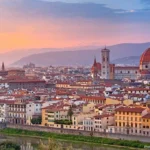
Nestled along the banks of the mighty Nile River, Cairo, Egypt’s sprawling capital, stands as a testament to the confluence of ancient history and vibrant modernity. With its roots reaching back to the 10th century AD, Cairo has grown into a metropolis of over 20 million people, captivating the world with its diverse culture, historical landmarks, and the ebb and flow of everyday life. In this exploration, we delve into 25 historical facts and numerical trivia that unravel the tapestry of Cairo’s past and present, unveiling the city’s significance as a cultural crossroads, an architectural marvel, and a resilient hub that continues to thrive amidst the challenges of the contemporary world. Join us on a journey through the heart of Egypt, where the echoes of pharaohs and the pulse of a modern metropolis harmonize in the vibrant mosaic that is Cairo.
Foundation and Antiquity: Cairo, established in the 10th century AD, carries within its streets and structures a rich tapestry of history. Founded as the royal city of Al-Qahira, it replaced Fustat and became the epicenter of political and cultural life in Egypt. This marked a pivotal moment in the nation’s history, as Cairo evolved into a bustling hub that would witness the rise and fall of dynasties, shaping the trajectory of Egyptian civilization.
Population Growth: Cairo, with a population exceeding 20 million, is not merely a city; it’s a vibrant mosaic of cultures, religions, and traditions. As the largest city in Egypt and the Arab world, its demographic dynamism makes it a melting pot of diverse identities. This sheer size contributes to the city’s vibrancy, with its streets echoing the pulse of millions of lives intertwining in the pursuit of daily existence.
Historic Districts: Old Cairo, known as Masr al-Qadima, unveils ancient treasures that whisper tales of centuries past. The Ibn Tulun Mosque, with its grandeur dating back to the 9th century, stands as a testament to Islamic architecture. The Hanging Church, an iconic Coptic Christian site, serves as a poignant reminder of the city’s religious diversity, encapsulating the harmonious coexistence of different faiths over the ages.
Geographic Location: Cairo’s strategic positioning along the Nile River has played a pivotal role in its historical and economic significance. Serving as a bridge between Africa and the Middle East, the city has been a cultural crossroads, absorbing and disseminating influences that have shaped its character. The Nile, the lifeblood of Egypt, courses through the city, providing sustenance and shaping its identity.
Cairo Citadel: Constructed by Salah ad-Din in the 12th century, the Cairo Citadel is a formidable symbol of Islamic architecture and military might. Overlooking the city, it served as the seat of power for numerous rulers. Its towering walls and majestic mosques within tell tales of conquests and cultural flourishing, offering a glimpse into the historical resilience of the city against external pressures.
Tahrir Square: Tahrir Square, forever etched in the annals of modern Egyptian history, became the epicenter of the 2011 Egyptian Revolution. As the symbolic heart of political and social movements within Cairo, it echoed the aspirations of a nation yearning for change. The square witnessed historic gatherings, expressing the collective voice of the people and their quest for political reform and social justice.
The Great Sphinx and Pyramids: Although technically located in Giza, the Great Sphinx and the Pyramids are integral to Cairo’s historical narrative. Standing as guardians on the outskirts of the city, they are emblematic of ancient Egypt’s architectural prowess and hold the secrets of pharaohs and civilizations that once thrived along the Nile.
Al-Azhar University: Founded in 970 AD, Al-Azhar University stands as a beacon of Islamic scholarship. Its ancient halls have echoed with the footsteps of scholars for over a millennium. As one of the oldest Islamic universities globally, Al-Azhar continues to be a center of learning, shaping theological discourse and contributing to the intellectual legacy of the Islamic world.
Population Density: Cairo’s high population density is a defining characteristic that shapes its urban landscape. The crowded streets, bustling markets, and lively neighborhoods paint a picture of a city that pulses with energy. This density, while presenting challenges, also fosters a sense of community and shared experiences among its residents.
Islamic Cairo’s Architecture: The narrow streets of Islamic Cairo are a living testament to the intricate beauty of Islamic architecture. The Sultan Hassan Mosque, an imposing structure from the 14th century, and the Al-Rifa’i Mosque, with its stunning domes and minarets, showcase the artistic and architectural achievements of the Islamic Golden Age. These structures stand not just as monuments but as living witnesses to centuries of cultural flourishing in Cairo.
Traffic Congestion: Cairo’s streets are notorious for their heavy traffic, creating a daily challenge for its residents. The congestion is a result of the city’s rapid population growth and urbanization, coupled with the ever-increasing number of vehicles on the road. Navigating the bustling streets, honking horns and weaving through a maze of vehicles, has become an integral part of Cairo’s urban experience, shaping the daily routines and patience of its inhabitants.
Nile River Cruises: The majestic Nile River, flowing through Cairo, offers enchanting river cruises that provide a unique perspective on the city’s landmarks. These cruises, often taken during the evening, showcase Cairo’s illuminated skyline, creating a magical ambiance. As the boat glides along the Nile, passengers witness the city’s historical monuments bathed in light, providing a serene contrast to the vibrancy of Cairo’s daytime activities.
Cairo Tower: Standing tall at 187 meters, Cairo Tower is an iconic structure that has graced the city’s skyline since its completion in 1961. Offering panoramic views of Cairo, the tower has become a symbol of the city’s modernity. It has witnessed decades of change, providing a unique vantage point for residents and visitors alike to appreciate the sprawling metropolis and its evolving architectural landscape.
City of a Thousand Minarets: Cairo earned its nickname, the “City of a Thousand Minarets,” due to the countless spires that adorn its skyline. These minarets, rising above mosques scattered throughout the city, contribute to Cairo’s unique aesthetic. Each minaret tells a story of architectural beauty and serves as a visual testament to the city’s rich Islamic heritage, creating a skyline that is both distinctive and awe-inspiring.
Historical Libraries: Cairo boasts a rich literary heritage with institutions like the National Library of Egypt and the historic Dar al-Kutub. Founded in 1870, the National Library holds a vast collection of manuscripts and rare books, preserving Egypt’s written legacy. Dar al-Kutub, one of the oldest libraries globally, dates back to the Fatimid era, showcasing Cairo’s commitment to intellectual pursuits and the preservation of knowledge.
Muizz Street: Known as one of the oldest marketplaces globally, Muizz Street in Islamic Cairo is a historical gem. Lined with medieval architecture, the street is a living testament to Cairo’s commercial and cultural vibrancy. Its labyrinthine alleys are adorned with shops selling traditional crafts, spices, and textiles, providing a sensory journey through time and commerce.
Khedive Ismail: In the 19th century, Khedive Ismail initiated ambitious modernization efforts that transformed Cairo. Under his rule, the city underwent a significant expansion, marked by the introduction of European architectural styles and the construction of grand avenues. His vision shaped Cairo into a cosmopolitan city, blending traditional Egyptian elements with a touch of modernity.
Post-Egyptian Revolution Cultural Renaissance: Following the 2011 Egyptian Revolution, Cairo witnessed a cultural renaissance. The city became a canvas for street art and a stage for underground music and theater movements. This cultural resurgence symbolizes the resilience of Cairo’s artistic community and its ability to reflect societal shifts through creative expression.
Animal Rights Movement: Cairo has seen a burgeoning animal rights movement, with organizations advocating for the welfare of animals. This includes efforts to address issues like stray animal populations and improve conditions for working animals. The movement reflects a growing awareness of animal rights and welfare within the city’s evolving social landscape.
Zamalek Island’s Green Oasis: Zamalek, an affluent district located on Gezira Island in the Nile, is often referred to as Cairo’s green oasis. Dotted with parks, gardens, and upscale residences, Zamalek provides a serene escape from the city’s hustle and bustle. The district’s tranquil ambiance, coupled with its cultural and culinary offerings, makes it a unique and sought-after part of Cairo.
Cairo Metro: Established in 1987, the Cairo Metro stands as one of the oldest in both Africa and the Arab world. It plays a pivotal role in the city’s transportation infrastructure, offering a solution to the challenges posed by Cairo’s notorious traffic congestion. The metro system not only facilitates daily commutes but also serves as a reflection of Cairo’s commitment to modernization and efficient urban planning.
City of the Dead: The City of the Dead, a vast cemetery, is a unique facet of Cairo’s social fabric. Inhabited by people seeking affordable housing, this unconventional neighborhood is a fascinating blend of history, spirituality, and daily life. The juxtaposition of mausoleums and makeshift homes underscores the complexities of urban living in Cairo and the adaptive spirit of its residents.
Growth as a Film Hub: Cairo has been a significant player in the Egyptian and Arab film industry. The Cairo International Film Festival, inaugurated in 1976, has become a prestigious event, attracting filmmakers, actors, and cinema enthusiasts from around the world. The festival not only showcases cinematic excellence but also contributes to Cairo’s cultural prominence as a hub for the arts.
Cairo’s Smog Issues: The city has grappled with air pollution, especially during the winter months, impacting the health and well-being of its residents. Cairo’s smog issues highlight the environmental challenges associated with rapid urbanization and industrial growth. Efforts to address air quality concerns underscore the need for sustainable development practices in the face of urban expansion.
Historical Resilience: Throughout its long history, Cairo has displayed remarkable resilience in the face of challenges. From political transformations to socio-economic shifts, the city and its inhabitants have adapted and persevered. Cairo’s resilience is not merely a historical footnote; it’s a living narrative, echoing through its streets, monuments, and the spirit of its people. This enduring quality defines Cairo as a city that continues to evolve while staying rooted in its rich heritage.








